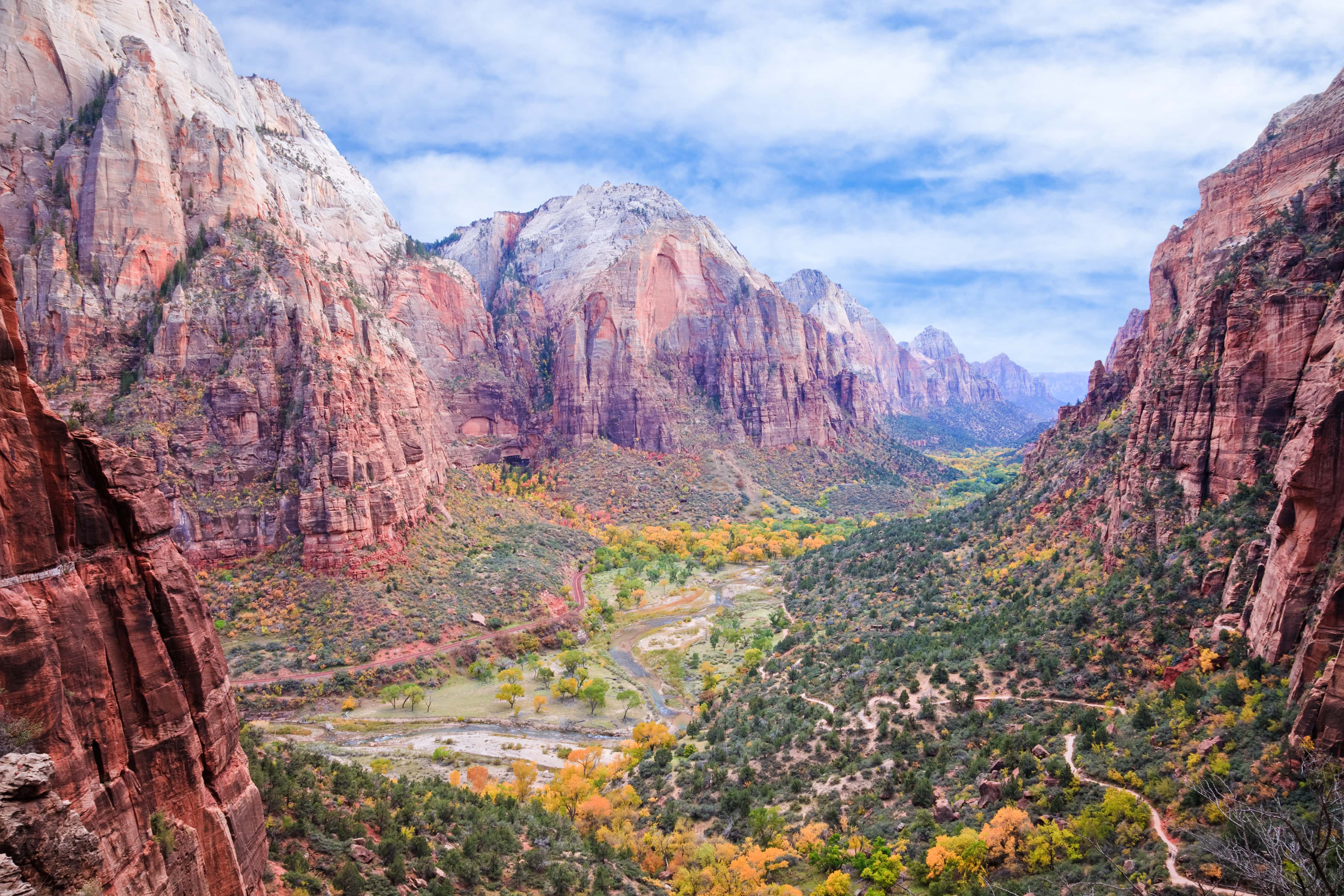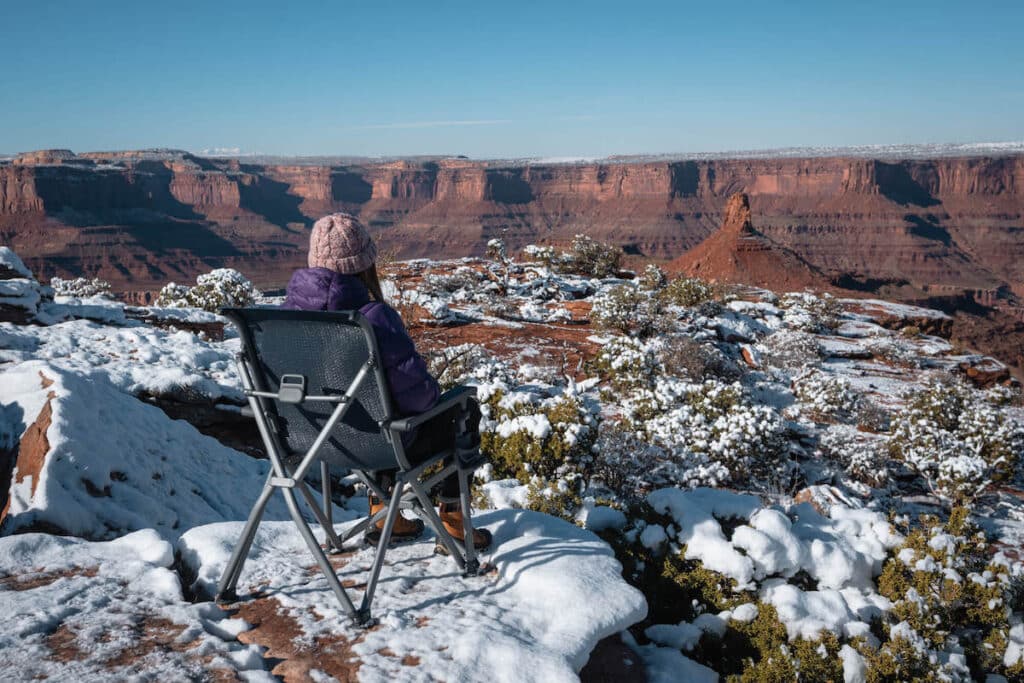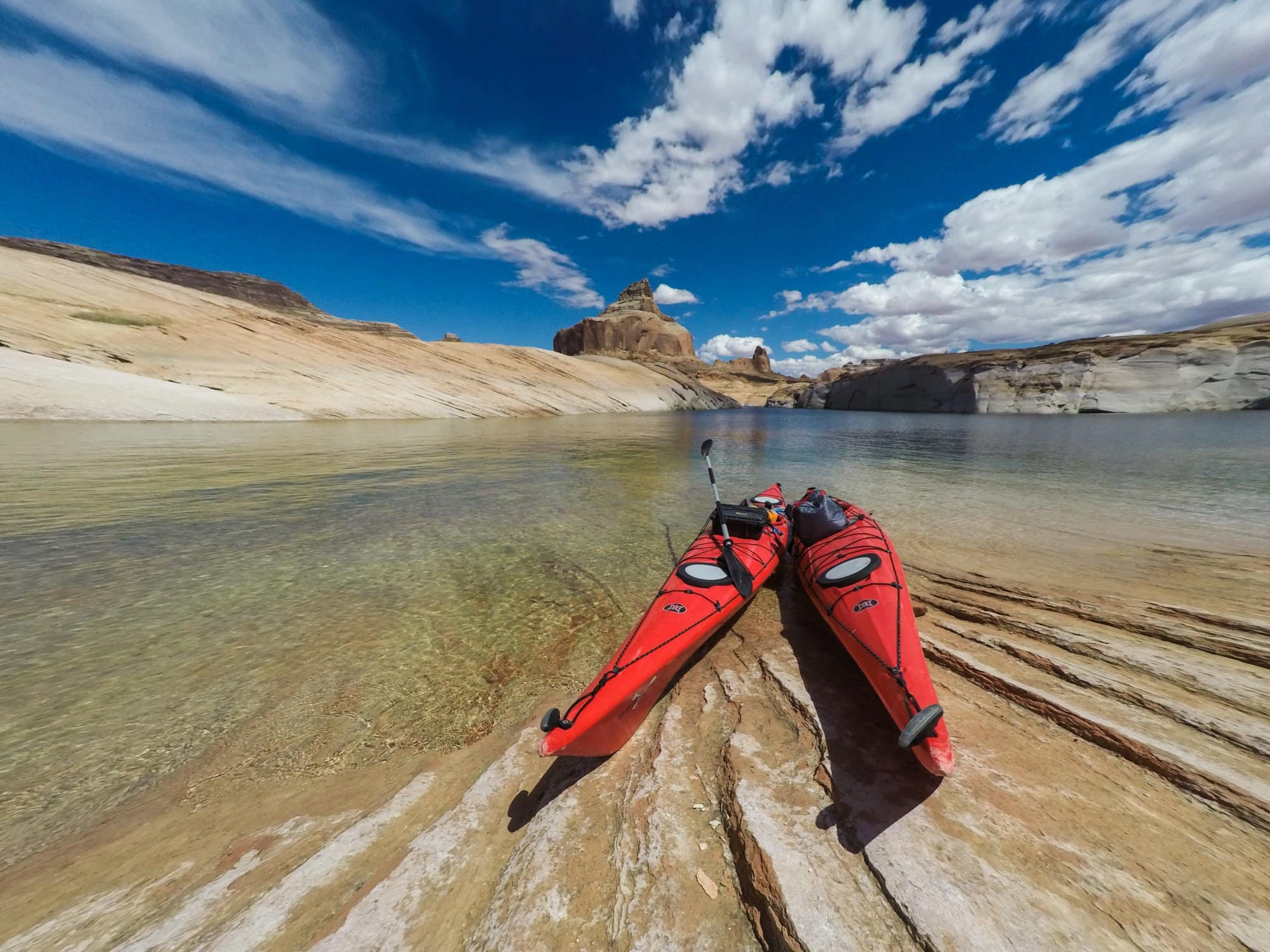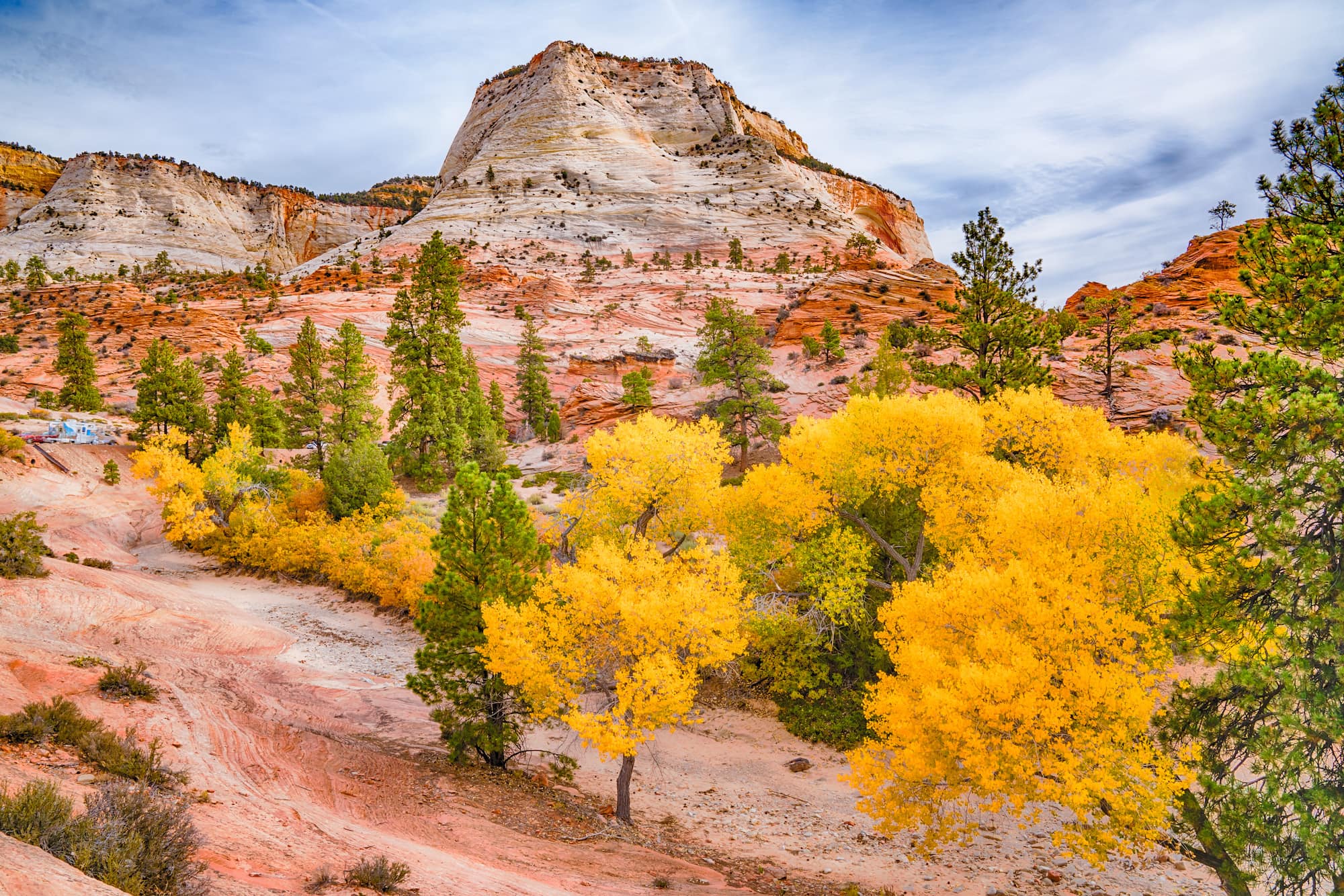Best Time to Visit Utah National Parks
Planning a trip to Utah’s Mighty 5 National Parks? Here’s the lowdown on the best times to visit.

I’ve lived in Utah for 10 years, and I cringe anytime someone tells me they are planning a summer trip to Utah’s National Parks. Don’t you know how hot it gets here?!?
Southern Utah’s National Parks are some of the most iconic and breathtaking of all our public lands. Whether you’re coming to see the mesmerizing red rocks, hike slot canyons, or take in the otherworldly qualities of Utah’s Mighty 5, it will be a trip you won’t forget. But, if you shouldn’t come in summer, now you might be wondering, when is the best time to visit Utah’s National Parks?
If summer is your only option, there are certainly ways to make it work, but spring and fall are far better choices as far as weather, and if you really want to beat the crowds, Utah’s National Parks have the least number of visitors in winter.
In this post, I give you the low down on what the different seasons are like in Southern Utah and how to best prepare.
This post may contain affiliate links.
Visiting Southern Utah in Winter
When you visit Southern Utah in the winter be prepared for temps between 25-50 degrees during the day and below freezing at night. If you’re willing and able to brave the cold, you will get to enjoy the parks without crowds and there might even be snow on the ground, which makes your photos even better in my opinion. Be prepared by bringing along warm winter layers that are also waterproof (it can rain or snow), and check with the National Park Service on current hazards. An icy layer on Utah’s slickrock can be extremely slippery, so if hiking is your goal, bring microspikes at a minimum or snowshoes depending on the weather.
Visiting Southern Utah in winter can also mean lower rates on accommodations in popular destinations like Moab, although services in some of the more remote parks like Capitol Reef can be limited. Bryce Canyon is the highest in elevation, so there you will have the greatest chance for snow and the coldest temperatures.
The downside of winter is certain trailheads are inaccessible – such as Lava Point in Zion which closes in winter – and roads to access dispersed camping can also be impassable. Some of Utah’s campgrounds close for the winter as well so be sure to check before heading out. As long as you are flexible and don’t have your heart set on a specific trail, winter can be a beautifully quiet time to visit Southern Utah.
Things to do in Winter in Southern Utah National Parks:
- Hike the Zion Narrows in a dry suit – I haven’t done this, but it’s on my Utah bucket list! If you plan to hike the Narrows, I recommend using trekking poles to help keep your balance hiking through the water in the canyon
- Photograph Bryce Canyon in snow and hike into the canyon if you have the right gear
- Drive Cathedral Valley in Capitol Reef National Park (check with a ranger on road conditions first as they can be impassable after wet weather)
- Enjoy crowd-free trails in Arches National Park
- Photograph and enjoy a late sunrise at Mesa Arch in Canyonlands


Save this post!
Enter your email & I'll send this post to your inbox! You'll also receive my weekly newsletter full of helpful advice for planning your adventures.
Get my Utah National Parks Checklist
Enter your email below to get this PDF guide on your phone, so you don’t miss anything on your Utah Road Trip!
Visiting Southern Utah in Spring
From April to May the Southern Utah parks are the busiest due to milder temps, spring blooms, and beautiful scenery. While Spring is undoubtedly the most pleasant season in Southern Utah, I personally like to avoid peak travel times like Spring Break, Memorial Day, and the weeks following graduation. Be prepared to deal with large crowds on iconic trails and plan to visit other less crowded areas as well. Check out this list of my favorite hikes in Utah to help you plan. Also, pay attention to event dates – like Jeep Week in Moab – which draws a big crowd around April every year.
Expect Spring weather in Utah to be slightly unpredictable, so pack accordingly. The daytime temperatures range from 60-80 degrees with lows around 40-60 overnight. Higher elevation trails and dirt roads can still be icy and snow covered or muddy due to snow melt.
If you are trying to snag a permit for a popular trail, like Arches National Park’s Fiery Furnace, make sure to plan in advance.
Things to Do in Spring in Utah’s National Parks
- Explore the depths of Canyonlands before it gets too hot – During the spring, you can explore Horseshoe Canyon Unit, a part of the remote area called The Maze, or for more beginner-friendly trails, visit The Needles Section for great backpacking and hiking. See the best Canyonlands hikes here.
- Beat the crowds on Angel’s Landing – Get up early or bring a headlamp and hike late in the day for the least amount of people on the trail. Read my complete guide to Zion National Park for details.
- See blooming wildflowers – In Zion and Southwest Utah, spot colorful blooms from late March to early May. In Canyonlands, Arches, and Southeast Utah, wildflowers peak a little later from late April to mid-May.
>> Read Next: What To Wear Hiking in The Desert

Visiting Southern Utah in Summer
Since the weather is harsh and daytime temps can reach over 100 degrees, summer is not the best time to visit Utah National Parks. With that said, tons of people visit in summer, and there are still plenty of ways to enjoy the parks if you’re there anytime from June to August. The good news is, sunset in mid-summer isn’t until almost 9pm. The best way to enjoy the summer is to tackle the toughest part of your hikes very early and/or late in the day and spend the hottest part of the day relaxing in the shade or swimming.
You’ll want to load up on sunscreen, wear a hat and other sun protection, and drink more water than you are used to. I also like to supplement our water with electrolytes in the summer since the sun can literally zap the energy right out of you. Permits are also hard to come by in the summer, so plan in advance.
Things to Do in Summer in Utah’s National Parks
- Hike the Zion Narrows – This world-famous hike is awesome to do in summer, as long as you can deal with crowds. The shade of the canyon walls and the refreshing water temps will keep you comfortable all day. Just make sure to check the weather forecast and make alternative plans if rain is possible due to flash flood potential. Want to get away from all the people? Do the Narrows from the top-down on an overnight backpacking trip, where a permit is required.
- Hike to Delicate Arch for sunset. Spend your day around Moab swimming or whitewater rafting.
- Explore Lake Powell – While not a National Park, Lake Powell offers awesome boating and kayaking in the summer months and is a welcome reprieve from Southern Utah’s summer heat. Check out our guide to planning an overnight kayaking trip on Lake Powell.

Visiting Southern Utah in Fall
Much like the spring, fall is a popular and busy season. It is one of the best times to visit Utah National Parks thanks to the mild weather and beautiful Fall foliage. Just be prepared to deal with crowds on popular trails. Our solution? Get off the beaten path and explore some lesser-known trails.
Be prepared with this Southern Utah packing list – we also recommend bringing a rain jacket and layers just in case. As winter approaches, weather can be erratic with chilly evening temps.
Things to Do in Fall in Utah’s National Parks
- Backpack the 14-mile West Rim Trail in Zion National Park. A permit is required which helps to keep the crowds at bay.
- Visit Grand Staircase-Escalante National Monument – Although it isn’t a National Park, the Grand Staircase-Escalante National Monument is close to many of Southern Utah’s parks and is a great stop if you’re on a road trip. It’s also got some of the best hikes in Southern Utah for catching the fall foliage down near the Escalante River. While there are some cool hikes right off the highway, you’ll want a 4×4 or high clearance for exploring the slot canyons and more secluded hikes off of Hole in the Rock Road.

My Favorite Utah Travel Resources
With cell service being limited in Southern Utah, it’s not a bad idea to invest in a hiking book or map for your trip. Here are the Utah hiking resources I’ve found to be most helpful over the years:
- Hiking from Here to WOW: Utah Canyon Country – this is hands-down the best book for finding Southern Utah hiking trails. It covers all of the Mighty 5 National Parks and more.
- Utah National Parks National Geographic Map Pack – this bundle includes Nat Geo topo maps for all 5 of Utah’s National Parks. These maps will give you the lay of the land, show you where the Park campgrounds are located, and feature all of the major hiking trails in the Parks.
- Utah Benchmark Road and Recreation Atlas – if you want to get off the beaten path and explore Utah’s dirt roads, this is a great atlas to have on your road trip.
- 60 Hikes Within 60 Miles: Salt Lake City – consider this your trail guide for the best hikes around Salt Lake City
Have you been to Southern Utah’s National Parks? In your opinion, what is the best time to visit Utah? Leave a comment below.


I have a good experience of Arches National Park because I have not been there in my whole life to enjoyed its outdoor activities and every time had huge fun there.
I would like to have information on maps to just go on scenic road trips in Sothern Utah. We are to old for hiking. We like back roads and old towns. We are staying in ST. George from the 3rd to the 8th of May. We will be driving a 4wheel drive truck. Any help would be apricated.
The Utah Road and Recreation Atlas is a great resource. It has information on camping, backroads, interesting stops, historic sites, and more.
We would like to visit Utah around May of 2022 would that be a good time to hike the narrows or would it be to cold,
May is usually a good time to hike the Narrows. You can read more about the Narrows and the best months to hike it in this blog post https://bearfoottheory.com/hiking-the-narrows-permits-and-planning/
Hi I’d like to plan a wedding. Nothing big just my fiancé and another couple. We are older but still enjoy hiking, biking, prefer something a little nicer for overnight. Do you have any suggestions? We are thinking May 2022. We also enjoy live music and if we can find a festival or concert going on at the same time that would just be a bonus! Thanks for any suggestions you might have. Lisette
Hi Lisette! There are a few glamping resorts near Zion and Moab that would be a nice option. Also my friend Kat Carney is an elopement photographer who specializes in the southwest and provides her clients suggestions so she might be worth reaching out to if you are also looking for a photographer: https://www.swellandstone.com/
Zion is pretty close to Vegas, about 2 hours, you could catch a show (maybe get married there) and head out to the trails before/after. If everything goes according to my dreams, this year I hope Phish is going to play Vegas Halloween shows and then my husband and I backpacking in Zion afterward.
Can you recommend places for hiking in Utah with a dog? I suspect a lot of parks aren’t pet-friendly..? We intend to stop for a short visit early September with our 1-year old Shiba 🙂 Many thanks in advance!
There are lots of great places to hike in Utah with a dog! It really depends on what part of the state you will be visiting.
My husband and I have flights booked to SLC mid September for 10 days. We’d loved to rent a camper van and go exploring but have heard that its impossible to get campsites in the national parks. If we arent able to stay in the national parks, will we have trouble finding alternative campsites? We’re hesitant to rent the van if we can’t secure places to go. Any suggestions on how we could find out? TIA
National Park campgrounds do tend to sell out about six months or more in advance. If you want to rent a campervan (which is a great way to see the parks!) I recommend reserving your National Park campsites as soon as possible. You can do this on Recreation.gov. This will make your trip less flexible, but you’ll be able to stay inside the Parks. There are also some independent campgrounds outside the parks if you want more flexibility, but again, availability isn’t guaranteed. September can be a busy time, so it’s best to book campsites in advance.
We are debating early March (first or second week) or late October (last week or two). Which one is best? Or any pro/con to consider?
Hi Scott, either of those are a great time to visit with nice daytime temps for exploring, but you may still run into snow on the ground in early March, and freezing temperatures at night. Late October could see the occasional snow shower but there wouldn’t be anything already on the ground like early spring. Temperatures would also be chilly at night then. Lastly, you may see early spring break crowds the second week of March. Be sure to pack layers no matter which shoulder-season month you end up visiting!